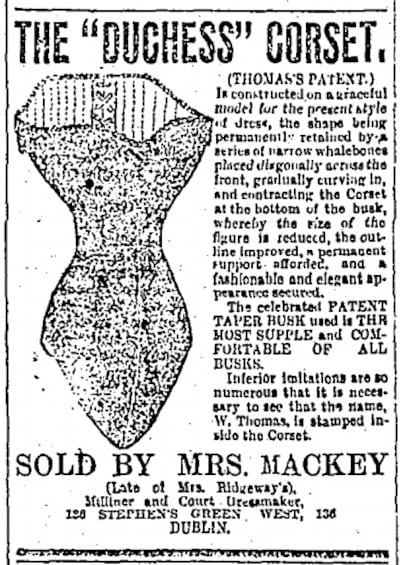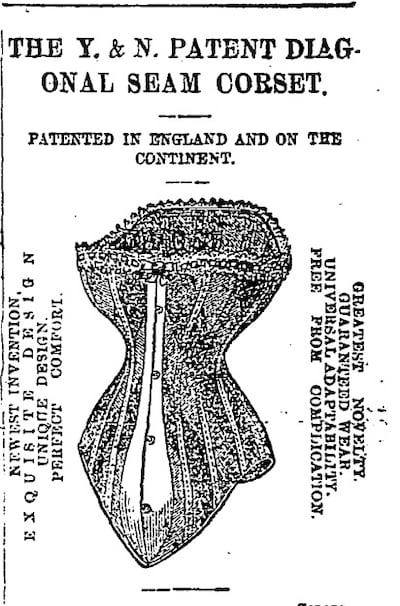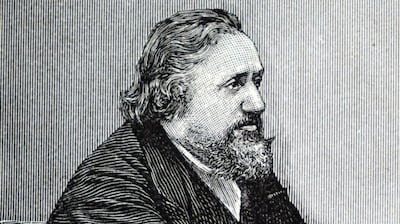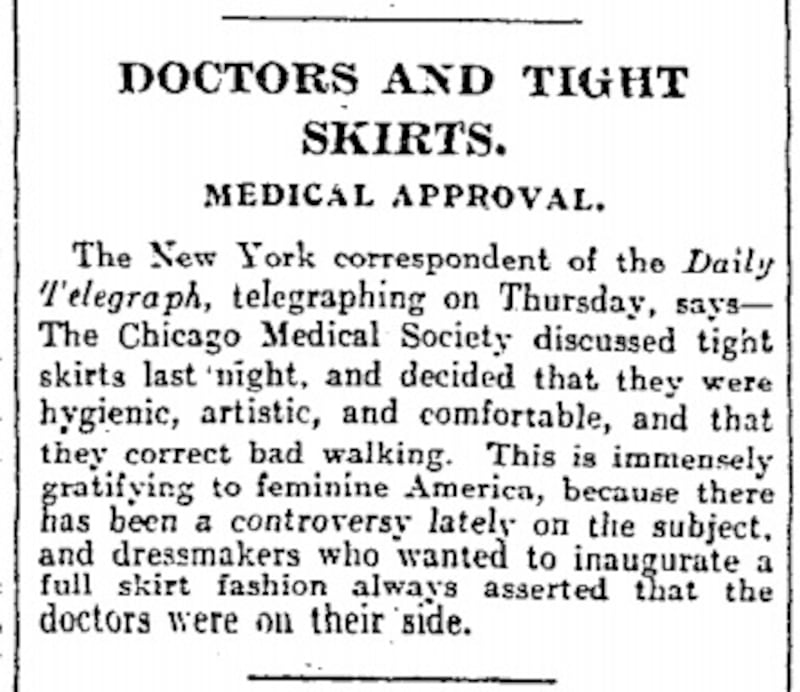Long, long before the first Irish mammy told a teenager, “Put on some clothes or you’ll catch your death,” the relationship between health and what one wore was a topic of much discussion and debate.

Benjamin Richardson was just one 19th-century doctor who became renowned for his views on "health and dress". In a speech to the London Institution in 1880, he called for reforms to women's dress styles on health grounds: "Tight bindings about the body, neck, feet and limbs. Corsets, waistbands, garters and tight shoes were especially denounced.
“The dress should be loose, and the weight of it should be borne by the shoulders . . . in women’s dress, dragging from the waist, there was produced such a waste of physical power that if women were in all respects free as men they could never approach to the position of men as active workers until they had emancipated themselves from this physical bondage.”
In Ireland, it was Dr Stewart Woodhouse who preached to audiences about the impact of dress on health, and he was quick to criticise the "objectionable" recommendation of the "London physician", "that dresses should be made to hang from the shoulders". His reasoning? "Growing girls and weakly women had sufficient difficulties as it was in holding themselves erect while carrying the head, neck and trunk and upper extremities without adding to the weight and dragging down the shoulders by the long and heavy skirts now worn."
Corsets

Both men, however, wanted to see an end to the wearing of restrictive and painful corsets and stays (stiff bodices).
In 1881, Dr Woodhouse told a Dublin lecture: “In a considerable proportion of women among hospital patients, and frequently in the cases of those in higher ranks, the stays were either too small or were fastened too tightly.”
The consequences, he said, “were dyspepsia and palpitation of the heart, the latter organ being only protected by the false or floating ribs. The mere compression, too, was not the whole of the evil for steels and whalebones added to the difficulties, and in some cases it was physically impossible for the wearers to run, stoop or take wholesome exercise. “
Dr Woodhouse, however, added that “stays of proper form” provided warmth for poorer women, and also offered “suitable support to adult women, especially if they inclined to corpulence”.
Richardson, meanwhile, advocated that the dress of women be the same as men's: "Let the mothers of England clothe the girls precisely as they clothe the boys, permitting knickerbockers if they like, and let them add the one distinguishing mark of a light, loose, flowing gown, and the girls will grow into women as vigorous, as healthy and as well formed in body as their companions of the sterner sex."

Readers were also informed of Woodhouse’s concerns “that women’s dress of the present period fell far short in several features of the sanitary ideal . . . first, unequal distribution of the heat-retaining power of clothes; and second, the unequal distribution of their pressure”.
The “upper and most vital half of the body” was insufficiently protected, he explained, “while perhaps five or six petticoats were unnecessarily employed to protect the limbs . . . The evil was much intensified in evening dress, when the neck and upper part of the chest were either entirely exposed to rapid variations of temperature and draughts, or were protected insufficiently by gossamer or muslin . . . how deleterious this mode of dressing was to delicate constitutions, inasmuch as consumption always began at the apex of the lungs, the parts contiguous to which were those most generally left unprotected.”
In addition to corsets, Woodhouse also wanted to eliminate “tight collars, sleeves and armholes” on health grounds, “inasmuch as they produce congestion by obstructing the return of the blood in the course of circulation. No dress could be considered hygienic which did not allow the arms being raised to the head.”
He also warned against veils being worn over the face. These. he said, “strained the eyesight and disturbed the vision, especially those ornamented with spots.They might cause nervous headaches and other afflictions of the head.”

Fabrics
The pros and cons of different fabrics were another source of much discourse. In 1878, scientist Dr Gustave Jaeger argued that woollen underclothing promoted better health, claiming it allowed perspiration to pass freely away, leaving the skin dry and warm. He later allowed his name to be used for a range of woollen undies. Richardson, however, recommended silk underwear, "and with that light fleecy flannel. Thick heavy flannel, and every material that absorbed and held the watery excretions from the skin were at all times bad."
Even the colour of clothes came under scrutiny. Richardson was just one doctor to agree with medical journal the Lancet that white was "the best colour of dress, even in cold weather" and black the worst.
Body-shaping underwear, however, remained the chief health concern. An 1882 report quotes the British Medical Journal: "The custom now is among ladies of 'ton' to wear a tea-gown . . . As its use usually enables the wearer to dispense with the corset, the hygienic value is apparent . . . If the tea-gown be the pioneer of other garments which may expunge corsets from the list of ladies' clothing it should indeed be welcomed."

Despite the best efforts of many medical professionals corsets continued to be worn. In 1893, Winifred E Dixon, LRCPSI, told an audience that “the wearing of corsets was objectionable on three grounds – they were unnecessary, unnatural and ungainly. Besides preventing the natural expansion of the chest they tended to cramp the body.”
And when the corset was finally abandoned, another restrictive fashion came under the scrutiny of physicians. In 1913 a short paragraph announced: "Doctors and Tight Skirts. Medical Approval. The Chicago Medical Society discussed tight skirts last night, and decided that they were hygienic, artistic, and comfortable, and that they correct bad walking."
- This is part of a series looking at the archives of The Irish Times concerning health.
1) Sleeping secrets: undress in the dark
2) Cooking for invalids: wine and champagne
3) Eat fat, no milk: 19 rules of long living
4) Bloody cures for women's periods
5) Electrical cures to revive sluggish functions
6) Your 'flatulence' explain your 'noises'
7) Curing psoriasis with nude sunbathing
8) Weight-loss: Obesity soap and fat massage
9) Institution Dubliners hoped they'd never enter
10) Cocaine Tooth Powder
11) 'Sun-ray' therapy
12) Men's hair products










